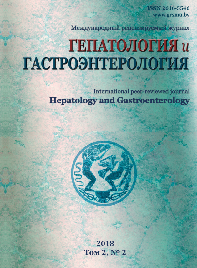OUR EXPERIENCE OF TREATMENT OF ESOPHAGEAL ATRESIA IN CHILDREN

Abstract
Background. Esophageal atresia is a malformation which is characterized by oesophageal obstruction. Objective. To study the results of treatment of esophageal atresia in the pediatric surgery clinic and to estimate the efficacy of the offered techniques.
Materials and methods. We carried out a retrospective (1992-2004) and prospective analysis (2005-2017) of the results of surgical treatment of patients with congenital oesophageal obstruction who received treatment in our clinic.
Results. The number of cases of anastomotic leak has decreased from 47.3% to 7.7%. The quantity of esophageal stenoses was 25.9% and there were no recurrences of fistula and bleeding. Postoperative lethality has decreased from 55.2% to7.7%.
Conclusion. In esophagel atresia with a diastasis between esophageal segments measuring 1.5-2.0 cm, the use of the method of fixation of segments of esophagus to a prevertebral fascia allows to impose primary or delayed anastomosis without tension which permits to avoid esophagoplasty and reduce disability. In esophagel atresia with a greater diastasis between esophageal segments the use of the method of proximal gullet bougienage with catheters for providing the feeding of newborns 3-4 times a day followed by serial check X-rays taken every 3 weeks allows to reduce diastasis and to impose delayed esophagoesophageal anastomosis. The developed method of treatment of TEF allows to avoid deformation of trachea and TEF recurrence. Application of the developed methods in treatment of patients with atresia allowed us to reduce the number of postoperative complications: anastomotic leak – from 47.3% to 7.7%, TEF recurrence – from 7.8% to 0, bleeding – from 15,7% to 0.
References
1. Krasovskaja TV, Golodenko NV, Mokrushina OG, Romanov AV, Kucherov JuI, Masenkov JuI, Fedin AV, Romanova LA. 10-letnij opyt lechenija novorozhdennyh jezofago-jezofagoanastomozom [The 10-year experience in the treatment of newboms by esophagoanastomosis]. Detskaja hirurgija [Pediatric surgery]. 2003;(6):5-8. (Russian).
2. Maev IV, Busarova GA, Samsonov AA, Petrakova OV. Anomalii pishhevoda [Anomalies of the esophagus]. Rossijskij zhurnal gastrojenterologii, gepatologii i koloproktologii [Russian journal of gastroenterology, hepatology, coloproctology]. 2005;15(3):13-22. (Russian).
3. Puri P, Höllwarth M, editors. Atlas detskoj operativnoj hirurgii [Atlas of pediatric surgery]. Nemilova TK, translator. Moskva: MEDpress-inform; 2009. 648 p. (Russian).
4. Nemilova TK, Bairov VG, Kagan AV, Karavaeva SA, Levadnev JuV, Ljubimenko VA. Atrezija pishhevoda: 48-letnij opyt lechenija v Sankt-Peterburge [Esophageal atresia: 48 years of treatment experience in St. Petersburg]. Detskaja hirurgija [Pediatric surgery]. 2003;(6):14-16. (Russian).
5. Chepurnoj GI, Chepurnoj MG, Rozin BG, Kacupeev VB, Maklecov EG, Shtejnberg NJu, Ilin AV. Atrezija pishhevoda s nizhnim traheopishhevodnym svishhom i aplaziej zheludka [Oesophageal atresia with a lower tracheoesophageal fistula and gastric aplasia]. Detskaja hirurgija [Pediatric surgery]. 2011;(3):53. (Russian).
6. Bairov GA, Doroshevskij JuL, Nemilova TK. Atlas operacij u novorozhdennyh [Atlas of operations in newborns]. Leningrad: Medicina. Leningradskoe otdelenie; 1984. 256 p. (Russian).
7. Skarsgard ED. Dynamic esophageal lengthening for long gap esophageal atresia: experience with two cases. J. Pediatr. Surg. 2004;39(11):1712-1714.
8. Lopes MF, Reis A, Coutinho S, Pires A. Very long gap esophageal atresia successfully treated by esophageal lengthening using external traction sutures. J. Pediatr. Surg. 2004;39(8):1286-1287.
9. Navasad VV. Kompleksnoe vosstanovitelnoe lechenie vrozhdennoj neprohodimosti verhnih otdelov pishhevaritelnogo trakta u detej [Complex rehabilitation treatment of congenital obstruction of the upper digestive tract in children] [dissertation]. Grodno (Belarus): Grodno State Medical University; 2013. 112 p. (Russian).
10. Sroka M, Wachowiak R, Losin M, Szlagatys-Sidorkiewicz A, Landowski P, Czauderna P, Foker J, Till H. The Foker technique (FT) and Kimura advancement (KA) for the treatment of children with long-gap esophageal atresia (LGEA): lessons learned at two European centers. Eur. J. Pediatr. Surg. 2013;23(1):3-7. doi: 10.1055/s-0033-1333891.
11. Parshikov VV, Zheleznov AS, Strizhenok DS, Ploharskij NA. Analiz oslozhnenij hirurgicheskogo lechenija atrezii pishhevoda u novorozhdennyh [Analysis of complications of surgical treatment of esophageal atresia in newborn infants]. Rossijskij vestnik detskoj hirurgii, anesteziologii i reanimatologii [The Russian Bulletin of pediatric surgery, anesthesiology and critical care medicine]. 2011;(2):30-32. (Russian).
12. Averin VI, Nesteruk LN, Grinevich JuM. Blizhajshie i otdalennye rezultaty jezofagokoloplastiki pri atrezii pishhevoda u detej [Outcomes of colon esophageal replacement for esophageal atresia]. Rossijskij vestnik detskoj hirurgii, anesteziologii i reanimatologii [The Russian Bulletin of pediatric surgery, anesthesiology and critical care medicine]. 2011;(1):34-39. (Russian).
13. Kavalchuk, VI. Navasad VV, inventors; Grodno State Medical University, assignee. Metod lechenija atrezii pish-hevoda u detej [Method of treatment of esophageal atresia in children]. Instrukcija po primeneniju BY № 038-0313. 05.04.2013. Grodno, 2013; 6 p. (Russian).
14. Kavalchuk VI, Navasad VV, inventors; Grodnо State Medical University, assignee. Method of surgical treatment of esophageal atresia. BY patent 12192. 2009 Aug 30. (Russian).
15. Kavalchuk VI, Navasad VV. inventors; Grodnо State Medical University, assignee. Method of surgical treatment of tracheoesophageal fistula in esophageal atresia. BY patent. 12503. 2009 Oct 30. (Russian).
16. Navasad V, Kavalchuk K, Navasad K. Results of surgical treatment of esophageal atresia in children. In: Treilona M, editor. The 12th Conference of the Baltic Association of Paediatric Surgeons. Final programme and abstracts; 2012 May 17-19; Riga, Latvia. Riga: Riga Stradins University; 2012. p. 54.
17. Kavalchuk VI, Navasad VV, Hmelenko AV. Ballonnaja dilatacija rubcovyh stenozov pishhevoda posle korrekcii atrezii pishhevoda [Balloon dilatation of cicatricial stenosis of the esophagus after correction of esophageal atresia]. In: Aktualnye voprosy detskoj hirurgii [Topical issues of pediatric surgery]. Materialy VI nauchno-prakticheskoj konferencii po detskoj hirurgii s mezhdunarodnym uchastiem; 2013 Maj 23-24; Brest. Hirurgija. Vostochnaja Evropa [Surgery. Eastem Europe]. 2013;(Suppl):72-75. (Russian).

















1.png)






